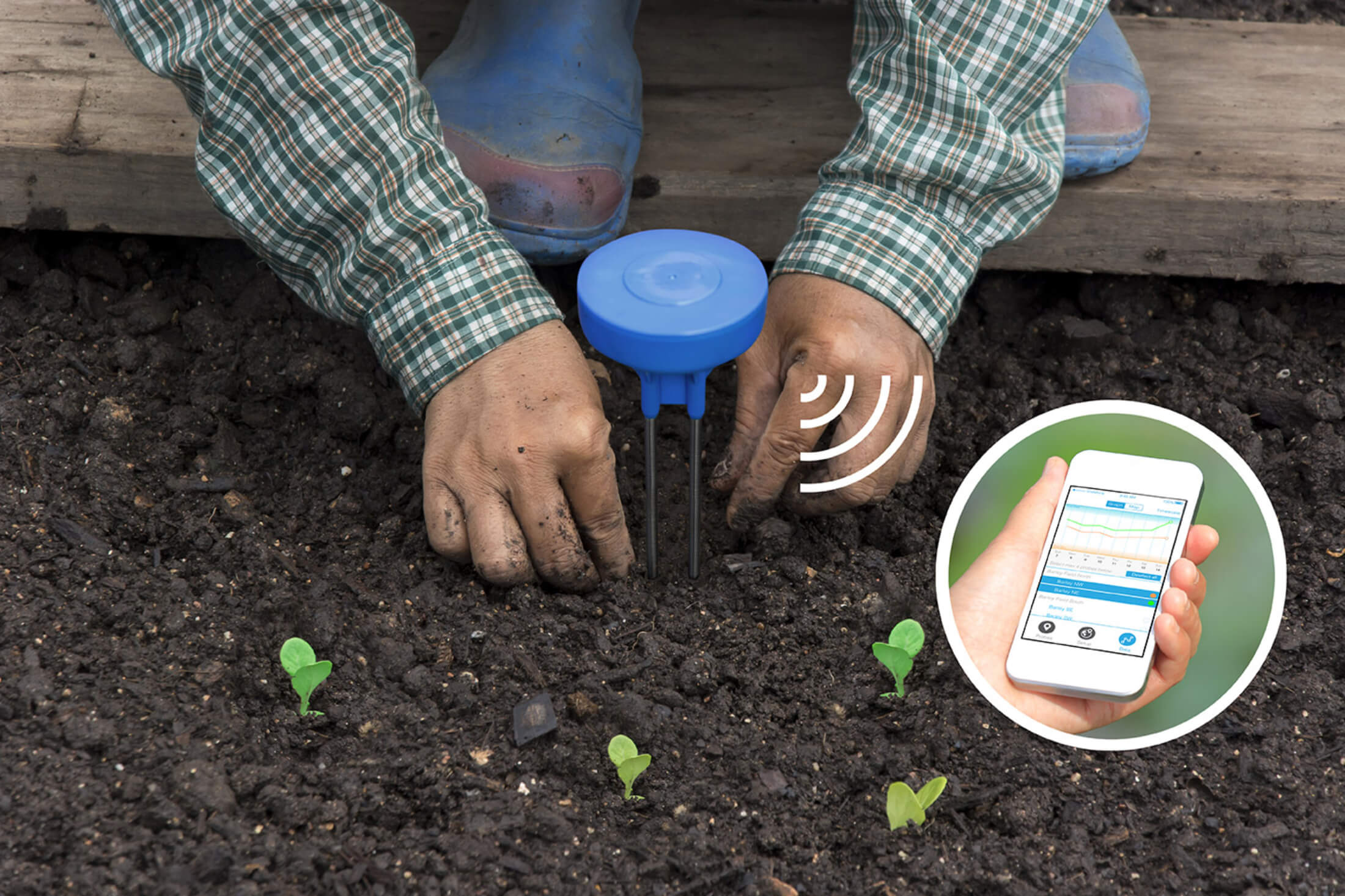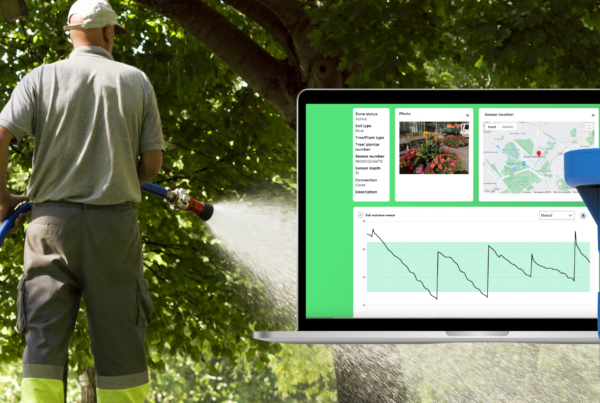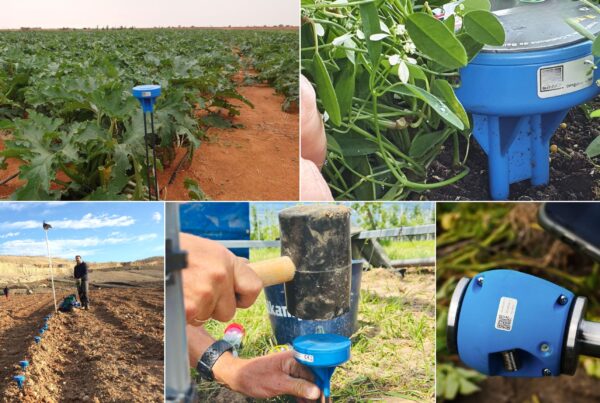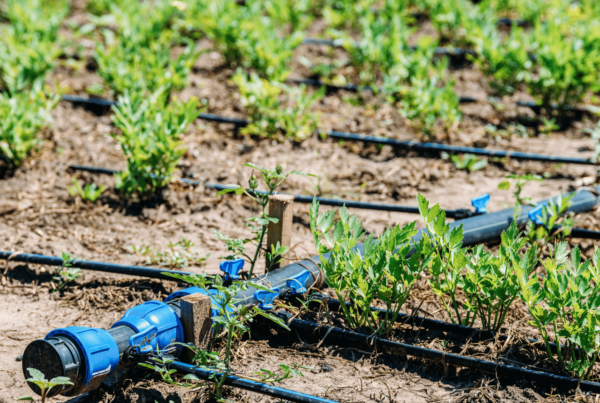Sensoterra is employing Kerlink’s reference design to build LoRaWAN sensors that can be provided to farmers, horticulturists and landscapers with a real-time soil-moisture managing system to reduce water consumption, chemical needs, fuel and labor.
Jul 10, 2019—Soil-moisture solutions company Sensoterra is ramping up its LoRaWAN-based technology sales by partnering with Internet of Things (IoT) company Kerlink. By using the Kerlink reference design in its wireless sensors, Sensoterra intends to provide wireless soil-moisture sensors faster, and in larger numbers, than before, and to make them available globally. Sensoterra already has approximately 5,000 sensors installed at its customers’ fields across 22 countries, but it needed the ability to scale up quickly since several large customers are preparing for wide-scale rollouts, says Christine Fraser-Boer, Sensoterra’s chief operating officer.
Sensoterra makes its own sensor and gateway hardware, and also offers software to manage sensor data, but it will now use the reference design from Kerlink to make it possible to quickly build LoRaWAN sensors for customers located anywhere around the world. The sensor company is using its existing moisture sensors, plastic housing and printed circuit boards; leveraging circuitry from the Kerlink reference design to make new circuit boards; and optimizing and improving the antenna. The use of the Kerlink reference design, Fraser-Boer says, “helps provide us with a faster go-to-market strategy,” thereby enabling customers to have fully mature solutions in their hands at a faster rate.
Amsterdam-based Sensoterra is a two-and-a-half-year-old company that focuses on soil moisture intelligence. Its wireless sensors, staked into soil, utilize LoRaWAN connectivity to send readings about the moisture levels in that soil to a gateway, as well as to its hosted server, via 4G or another available network. The company’s software manages that data and can provide real-time alerts and historical data for analytics purposes.
Sensoterra initially offered its solutions on a business-to-business basis, Fraser-Boer says, with its systems used in the industrial and agriculture markets. However, the global nature of its customers, which are based in Europe, North America and Asia, as well as the multiple use cases involved, required some customization of the sensors. LoRaWAN frequency requirements vary from the European Union (863 to 870 or 433 MHz) to the United States (902 to 928 MHz). Kerlink’s reference design can accommodate all of those frequencies, according to Guillaume Boisgontier, the company’s manager of innovative products and solutions marketing.
“Kerlink allows us to program our software for use with the same base product,” Fraser-Boer states, no matter where it will be used around the globe. When it comes to applications, Sensorterra’s sensors are employed in several ways. In the horticulture market, companies can use them to track soil-moisture levels around trees to enable better irrigation decisions, thereby reducing the need to over-water. This, on the other hand, ensures that sufficient water is applied.
The systems are also utilized in agriculture for similar irrigation decisions across fields in which everything from soy to strawberries grow. Typically, Sensoterra provides six to ten sensors per 120 acres, as well as a gateway to receive the devices’ LoRaWAN transmissions. The sensors can be used more or less densely, depending on the sensitivity and value of the crops being monitored.
Thirdly, the solution is being employed in cities by landscaping businesses. By installing sensors at the gardens and lawns where such companies provide their services, they can view the real-time conditions of the soil and adjust watering accordingly, thus providing their private or public customers with a system that prevents water waste. “Everything the data provides is about making smart decisions and better use of resources,” Fraser-Boer says.
The solution is designed not only to prevent over- or under-watering, but also to reduce additional expenses involving such errors. For instance, more watering requires more fertilizer and pesticide applications, as well as diesel to operate the watering and chemical application—all of which might be unnecessary with better-managed watering. By making sure the soil is sufficiently moist, however, users can ensure the highest yield or healthiest garden.
Once the system is installed, Fraser-Boer reports, a return on investment can typically be accomplished within a single season or growth cycle. The sensors are designed with an average battery life of three years. In outdoor applications, however, the sensors may be removed during off-seasons.
All Sensoterra sensors transmit data via LoRaWAN to the gateway, which transfers a packet of data about the moisture sensor readings, linked to the unique ID number of each sensor, to the cloud-based software. “We process the data in the cloud,” Fraser-Boer explains, and her company then provides an app for workers to access on a smartphone or tablet, along with a portal to view the dashboard. If conditions require watering or the cessation of watering, an alert can be issued to authorized parties. Additionally, the data can be viewed on a dashboard so workers can better understand conditions and the corresponding health of plant grown in the soil.
Some of Sensoterra’s customers use the cloud-based server, while others prefer to utilize an application programming interface to connect the data directly with their own management software. There, they can compare soil moisture with other information, such as weather data or information captured by drones regarding a crop’s health. The software can also be linked to irrigation valve actuators in order to prompt automatic watering or shut that watering off. The system is designed for ease of use, Fraser-Boer says. Users can flip the sensors upside down to turn them on, then hammer them into the soil. The gateway will then begin capturing data, and users can access that information on their mobile phones within about an hour.
Rollouts of LaRaWAN solutions vary based on location. In some places, Boisgontier explains, such as in the Netherlands or India, a LoRaWAN connection is available across the countries so deployments are easier, while in other areas, Sensoterra installs gateways. Kerlink works with public service providers that offer 3G or 4G cellular connectivity who may want to apply LoRaWAN to their service, he says, as well as with private operators that are industry-specific “for customer use cases that might be deployed locally.”
Sensoterra’s solutions track soil-moisture data only, and the company finds that many of its customers use the soil-sensor system as the first foray into wider IoT solutions. “Once they have the system in place,” Boisgontier says, “with a network, and sensors around the farm, you can add to that solution” with air temperature, light or any of hundreds of different types of sensors capturing unique data. Sensoterra sold approximately 4,000 sensors in 2018, but it expects the number to be between 8,000 and 10,000 this year, with the largest rollouts occurring during the third and fourth quarters with several large customers that have asked to remain unnamed.
For Kerlink, the goal is to provide the universal reference design for Sensoterra’s sensors. “We are not a device maker, but the radio expert for companies that want to design their own LoRaWAN sensor,” Boisgontier says. Kerlink’s reference design has helped not only with radio transmission for global requirements, but also with battery optimization. Therefore, Sensoterra’s customers will not have to wait for testing a prototype.
“What we are providing is a dedicated approach for each customer to design the device” according to its needs, Boisgontier says, while meeting the LoRa specification for each geographic location. In most parts of the world, Fraser-Boer adds, Sensoterra can now deliver the sensors required for a customer rollout within about two weeks. They are designed to be installed by a user within about 30 seconds per sensor.






